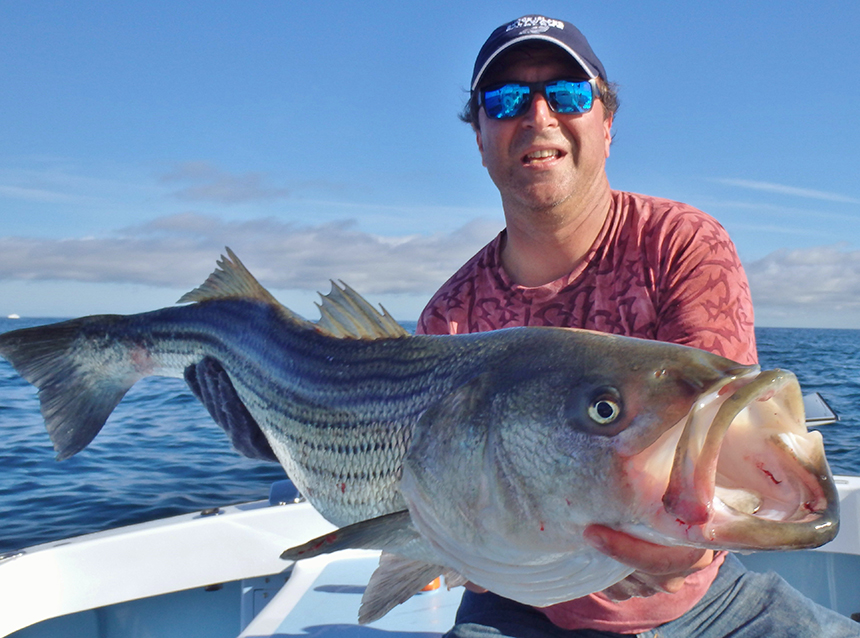By SARAH PUSCHMANN/ecoRI News
contributor
 |
| Steve Brustein of West Warwick, R.I., with a Block Island striped bass caught on the Southwest Ledge. (R.I. Saltwater Anglers Association) |
In response, the Atlantic
States Marine Fisheries Commission in August issued a collection of possible
management options for recreational and commercial fishing, with the
goal of reducing the rate of Atlantic striped bass killed by fishing to 18
percent less than the 2017 rate by 2020.
This isn’t the first time striped bass have stared the Grim Reaper in
his piscine eyes.
Back in the 1980s, the population of striped bass that the Atlantic States Marine Fisheries Commission manages — which ply the coastal waters between North Carolina and Maine in search of menhaden, a type of herring — declined so drastically that the commission called a complete moratorium on striped bass fishing.
Back in the 1980s, the population of striped bass that the Atlantic States Marine Fisheries Commission manages — which ply the coastal waters between North Carolina and Maine in search of menhaden, a type of herring — declined so drastically that the commission called a complete moratorium on striped bass fishing.
It worked. By 1995, the population
had climbed to record levels. That year 540,000 fish were caught commercially,
a sharp increase from the 272,000 caught in 1983. A New York Times article from
June of that year jubilantly announced the fish’s “comeback.” With the population
restored, restrictions were lifted, and the fish’s numbers remained relatively
stable.
To keep tabs on the health of a fish population, biologists check two key indicators. One is the rate of death due to fishing, known as fishing mortality, and the other is the combined weight of all females in a population capable of spawning, known as spawning stock biomass — so, one indicator to judge rate of death and another to judge the potential for birth.
After 1995, the death indicator hovered just around the threshold of concern, while the birth indicator was steadily worsening, it didn’t yet trip the worry-wire.
Then, in 2013, the mortality rate
exceeded the level of concern, leading the Atlantic States Marine Fisheries
Commission two years later to decrease the number of fish anglers could take
per day from two to one.
But it wasn’t until 2018, when the model that biologists use to determine the health of fish populations, the Marine Recreational Information Program, was recalibrated that a startling discovery was revealed.
But it wasn’t until 2018, when the model that biologists use to determine the health of fish populations, the Marine Recreational Information Program, was recalibrated that a startling discovery was revealed.
The most recent data showed that the
spawning stock biomass was only 151 million pounds in 2017, far below the
newer, higher threshold of 202 million pounds.
“Previously, we thought we were
actually above the threshold and now we add in these new numbers, we run the
model and we found out wow, we’re not only below [the threshold] but we’ve been
below it for five years,” said Nicole Lengyel Costa, biologist for the Rhode
Island Department of Environmental Management’s Division of Marine Fisheries.
This has prompted the Atlantic
States Marine Fisheries Commission to propose Draft Addendum VI, a set of
management options designed to protect the population. One way to do this could
be to decrease the number of dead releases by tackling the types of hooks that
cause them.
Currently, anglers are allowed to
take one fish of a minimum length of 28 inches per day. Quite often, though,
the first, second, or third catch is too small to be legal, so the angler
throws it back. Of the released striped bass, which the Atlantic States Marine
Fisheries Commission estimates this to be 9 percent of all striped bass caught,
most don’t actually rejoin the population. They die. In fact, in 2017, 91
percent of releases were dead.
“There are more fish that die that
way than anglers taking them out of the water bringing them home to eat,” said
Dave Monti, second vice president of the Rhode Island Saltwater Anglers
Association and charter boat captain who takes anglers out into
Narragansett Bay to fish for striped bass in the spring.
“That’s how dramatic it is,” he
said.
Dead releases mainly occur when a
fish is hooked not in the mouth but in an internal organ as a result of
swallowing the hook. This is why the Atlantic States Marine Fisheries
Commission hopes to steer anglers away from using the more easily swallowed
J-hooks and toward using circle hooks, which are more likely to puncture a fish
in the mouth, not the gut.
This provision, plus other options
to decrease the mortality rate of striped bass, including increasing the
minimum size allowance or restricting the fish anglers can keep to within a
particular size range, are outlined in Draft Addendum VI.
The public comment period for this
addendum closed Oct. 7. The Striped Bass Management Board will consider
the public comments and is scheduled to meet Oct. 30 to select which management
options to implement.
Sarah Puschmann is a reporting
fellow with ecoRI News.